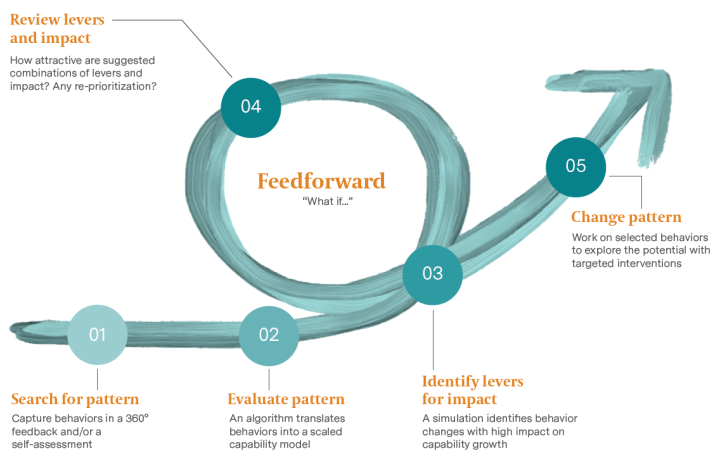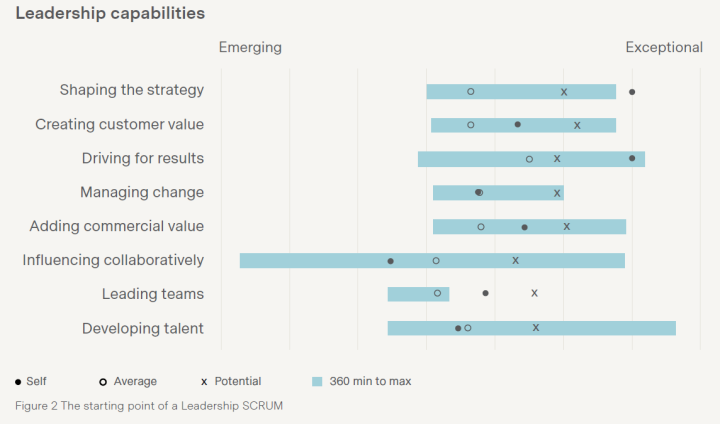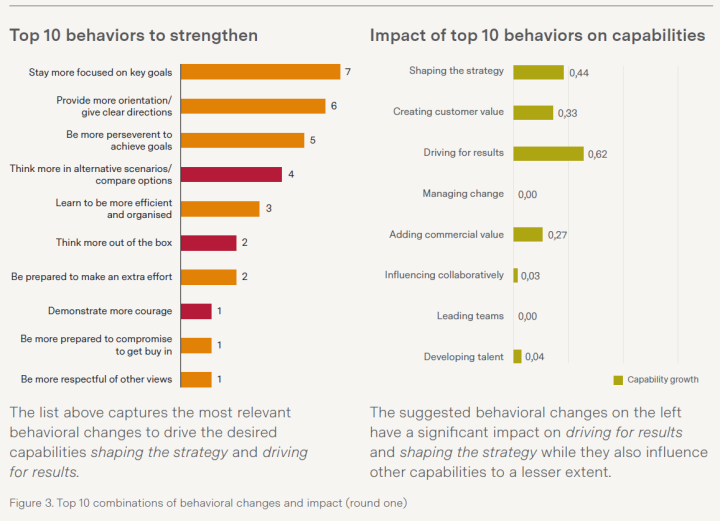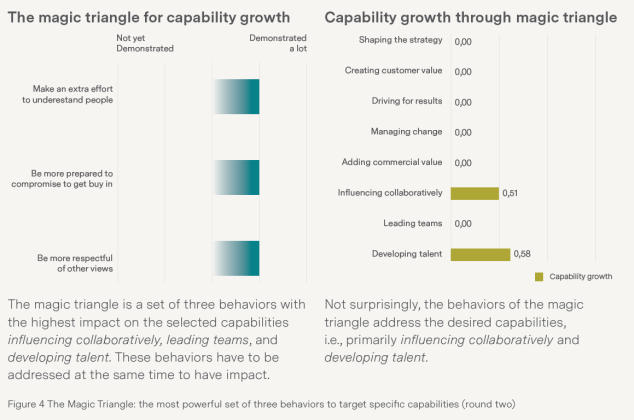Large organizations typically invest heavily in leadership development, but often don’t get the expected return on investment. Leadership SCRUM is a high-touch method that is available at a reasonable cost and with limited distraction to the organization. It provides powerful customized feedforward for executives on how to improve leadership capabilities.
Why is it effective? Because the output of a Leadership SCRUM session is a relevant starting point for a tailored development journey for the executive. This is a proven, structured method that focuses on identifying behavioral recommendations to improve leadership capabilities around three core pillars:
- Introspection: We capture specific behavioral patterns of an executive (360° and/or self-assessment) that are translated into a scaled leadership capability model as a baseline – leaders get an idea of where they stand.
- Inspiration: We identify individual behavioral changes with high impact on the scaled leadership capabilities to nurture a realistic ambition – leaders develop an idea of where they could be.
- Exploration: In a radically forward-looking approach we propose specific behavioral changes with high impact on growth in desired leadership capabilities – leaders get an idea on how to get there.
In essence, Leadership SCRUM inspires behavioral change for impact: “If I invest in changing a certain behavior, it will improve the desired capability!” The method calculates various combinations of behavioral changes and their specific impact on leadership capabilities and ranks them according to impact. The most compelling combinations can be used to inspire for additional leadership ambition. If executives are convinced about the value of an identified behavioral change, they are more likely to invest for the desired return—a great starting point for an individual development journey.
Agility in leadership development
We use the word SCRUM deliberately to indicate that we included principles of the agile development methodology in our approach. In fact, bringing the concept of agility to leadership development appears to be quite intuitive if we understand SCRUM as a framework to solve complex problems in an iterative, adaptive, and unrestrained way. When we developed this approach, we learned that the ideas of rapid adaption and change through continuous learning work very well in leadership development. The principles we apply in Leadership SCRUM are simple:
- We want to come to a first suggestion quickly with limited effort (minimum viable product)
- The first solution is taken as a starting point that is to be improved/validated continuously, taking input and considerations from different perspectives openly
- Solutions are measured and tested for their relevance in terms of expected impact
- Participants take ownership of a moderated process (i.e., they don’t consume the suggestions, but actively engage to shape the process and eventually own the output)
Figure 1. The Leadership SCRUM Methodology

Evaluate “What if Scenarios” in Feedforward Sessions
A Feedforward session is the core of our Leadership SCRUM approach (see Figure 1). The purpose is to identify the relevant drivers for change to achieve the desired outcome. During a session, we discuss combinations of suggested behavioral changes for specific results, looking back to identify demonstrated behaviors as a starting point – not to define the path to a generic ideal pattern of behaviors. We utilize an algorithm to calculate how sets of behavioral changes impact leadership capabilities, and if the first suggestion does not resonate, the next best suggestion is discussed.
We go through several circles to eventually get to the point where the recipient discovers, “This makes perfect sense! It really resonates!” If we come to that point, we have what we call the “hook.” This is a pivotal point in the process because the combination of behaviors and its impact obviously appeals to the recipient. When the participant is locked in, we might even go back to previous behavior/impact combinations that did not resonate at the time. Very often, the lock-in factor changes the perspective on previous suggestions, which are seen in a different light—now they begin to make sense, and a new ambition is created. This is a perfect starting point to strengthen the foundation of a transformative development journey.
A case study:
Let’s examine an example of a top executive who participated in a Leadership SCRUM exercise.
Figure 2. The starting point of a Leadership SCRUM

Comments on self-assessment and 360°
- Overall, the 360° view presents a balanced competence profile on a strong level – with a spike in driving for results.
- The 360° view represents a fairly wide corridor of views between the minimum and maximum score (i.e., there are different views ranging from moderate to high competence level).
- In particular, the 360° view shows a wide range in influencing collaboratively. This indicates
- that the executive is not seen consistently high in collaboration by the referees.
- In general, the potential X indicated by the 360° is high (i.e., every single competence shows leeway to develop in the future).
- The self-assessment oscillates around the 360° views. The executive overrates himself in his strengths driving for results and shaping the strategy while he sees himself more critical in influencing collaboratively.
We spent some time reflecting on the leadership capabilities baseline (Figure 2) on the executive’s self-perception versus the 360° view provided by the feedbackers (nine, in this case). Notably, the executive placed a much stronger emphasis on shaping the strategy and driving for results as strengths when compared to the reviewers; at the same time, the executive knew that influencing collaboratively was not a key strength. In this regard, he was even more self-critical than the referees, acknowledging that this was an important area for development. This is not an unusual starting point for very ambitious executives who display good self-awareness.
Once the development priorities are clear, relevant levers are identified
Note that neither referees nor the executive was asked to score directly on the scaled capabilities. The scores in the leadership capability model are calculated by an algorithm based on the interpretation of 70 simple behaviors in an expert system. The behaviors are analyzed and translated into the leadership capabilities with more than a thousand interdependencies per capability. It only takes computing power to calculate in a simulation how behavioral changes affect the capability profile. What is the impact if the executive displayed more of certain behaviors?
The algorithm simply recalculates the result of modified behavioral patterns and keeps track of the behavioral changes that lead to the highest improvement in the desired capabilities.
In the first step of the feedforward, we focused on the two capabilities where the executive overrated himself compared to the 360° references (shaping the strategy and driving for results). The key question was: What behaviors would he need to change for the highest improvement in these two capabilities and come closer to his own aspiration (Figure 3)?
Figure 3. Top 10 combinations of behavioral changes and impact (round one)

Among the behaviors the executive needed to strengthen, stay more focused on key goals and provide more orientation/give clear guidance stood out (the full list leads to the highest capability growth in the two leadership capabilities shaping the strategy and driving for results, while they also influence other capabilities but to a lesser extent).
At first blush, the behavior change recommendations may sound simple and almost a bit arbitrary. But they become more apparent as we deepen our conversations and may even spark important “a-ha” moments. In this case, the executive acknowledged having received prior feedback that he was someone who changed his priorities too often without being clear about the “why.” While he (gladly) confirmed his position as a strong strategic thinker, he came to realize that his ideas and pace of change were not sufficiently understood in the organization. This was a source of frustration, both for him and the company, by overplaying his results orientation. Coming to this realization was an important milestone.
He knew that influencing collaboratively wasn’t a key strength. He was struggling to be understood by the organization. So, it took no genius development advisor to determine that strengths such as shaping the strategy and driving for results weren’t scoring as high as the executive thought. This was because he did not connect well enough with the organization – hence the fairly low score in influencing collaboratively. The big takeaway from the feedforward was: The executive needed to maintain focus and provide more guidance without being too assertive. The question was, how could he develop and become more effective in providing guidance to his teams?
To answer this, we ask the algorithm which behaviors to change for the highest impact in improving influencing collaboratively as well as leading and developing his team.
Figure 4. The Magic Triangle: the most powerful set of three behaviors to target specific capabilities (round two)

The magic triangle is a set of three behaviors with the highest impact on the selected capabilities influencing collaboratively, leading teams, and developing talent. These behaviors have to be addressed at the same time to have impact. Not surprisingly, the behaviors of the magic triangle address the desired capabilities, i.e., primarily influencing collaboratively and developing talent.
The three behaviors with highest impact on core leadership capabilities were “make an extra effort to understand people”, “be more prepared to compromise to get buy in” and “be more respectful of other views.”
If you look at the positioning of the three blue markers on the left side of Figure 4, you will notice that their position leans more on the right side, meaning this behavior is already demonstrated. It is not on the far-left side which would indicate “not yet demonstrated at all.” The executive is already displaying the suggested behaviors, but he should show more of it. In his case we are talking about strengthening strengths to get to the desired results.
This was a lot to digest in a two-hour feedforward session, with the executive playing a very active role in the discussion.
A feedforward session to start the development journey
Undoubtedly, the real development work will begin with a Leadership SCRUM. As we mentioned, feedforward is only the starting point in a development journey, and the process of shifting behaviors in the desired direction is continuous and takes hard work and a systematic application of targeted interventions (for example, in the form of but not limited to coaching).
Feedforward sessions often lead to a real commitment to embrace the suggested behavioral changes for long-term transformation in the spirit of ongoing agile development as described above. Beyond bringing clarity on behavioral change, they are also inspirational and come to a turning point when the interconnections of seemingly unrelated behaviors are discussed – these connections are eye opening to the executive and create a powerful image in the “what-if-logic”. This is particularly interesting when pairing strengths with development areas—often too much of a good thing is counterproductive.
Handled wisely by the development advisor, feedforward sessions always lead to enough food for thought to start a journey as we are not pushing certain recommendations but try to help individuals to discover the benefit in behavioral changes for themselves. But ultimately, the whole exercise is only worthwhile if the ideas resonate and the executive commits to changing his or her behavior to achieve the desired impact.
Individual development journeys work particularly well when they are conducted in leadership teams. It provides enormous additional value for the organization when teams jointly reflect on aggregated behavioral suggestions. This leads to a higher awareness of the need for cultural adaptations and a joint commitment to work in a certain direction – individually and collectively. We have seen successful clients even sharing individual development recommendations to create transparency on individual development journeys. The concept of the learning organization works beautifully if stakeholders not only have a clear idea on their individual learning fields but also understand the aggregated development areas of the team.
For decades, leadership trainings included sections on “understand yourself and others” to interact more effectively today. Why not also create transparency on aggregated learning fields to work towards a new level of collaboration tomorrow by embarking on a concerted learning journey? The learning potential for the organization would be infinite!





